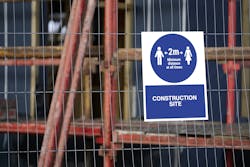Social Distancing Tech Solutions for Contractors
By Larry Dorie
The COVID-19 pandemic caused major disruption in nearly all industries, including those who work as general contractors. In the span of several months, workplaces throughout the nation have transformed and adopted new operating procedures that put social distancing concerns at the forefront of every other concern. Throughout the quarantine orders and even now during the slow re-opening we are seeing, general contracting employers have had to come up with a game plan for a safe return to work. Technological solutions are a key element in overcoming some of the biggest challenges to resuming work.
One of the greatest challenges lies in addressing how to bring workers back to job sites in a way that minimizes health risks, but also ensures operations are maintained at a level that allows the company to meet their target deadlines. This goal is particularly important for those in the contracting industry where work ebbs and flows with the seasons. We are at the height of summer, when many contracting companies are operating full steam ahead and trying to get as many jobs wrapped up as they can in a short amount of time.
Some in the industry have already fallen behind their initial project deadlines due to the setbacks with working this spring. And now, general contracting companies understand they must work quickly and efficiently in order to make up the ground they have already lost. Contactless and remote solutions provide great promise in the industry as they can enhance efficiency and productivity while preventing unnecessary physical contact.
Contactless technologies have the unique capacity to help contractors in the field – even those who are not fully trained yet and those who are not familiar with the details of a particular project – dive in and move forward with projects. They can use the platform to connect with tech experts in the home office to clarify any questions that may arise while working. These technologies represent a vast improvement over former methods for clarifying job-site questions. Workers get correct answers immediately rather than waiting for an email response or addressing uncertainty that may arise from a standard video feed.
In addition to functionality that supports HD-quality video calls, contactless solutions feature a unique drawing tool that works directly on the live video feed to make clear notes or identify precise areas of concern. Taken together, these features empower staff to work closely together without physical proximity, but still in a way that ensures problems are identified and resolved quickly, and uncertainties (which grow as project complexity grows) are addressed.
For example, contactless technologies can clarify any questions that arise while on the job site in real time, ensuring that there are no costly delays or miscommunications. During work on any type of building or structure, questions often arise about laying down pipes since it often requires high accuracy and may often come in conflict with other building systems. When questions like this arise, the field workers can show his supervisor a live video stream of the area in question and then use a digital drawing tool on the actual video to circle or point to the exact components that need to be addressed so they together can accurately install, repair or build in the correct area without a lot of verbal guesswork.
With virtual, contactless solutions (like TurboMeeting RemoteHand), clarity of the specifications can be realized immediately, ensuring the job is done right the first time. The convenience of these technologies can help maintain social distancing in the workplace while working on jobs of all sizes in both the commercial and residential contracting sector.
The potential uses of this type of technology in both contracting and building maintenance are incredibly widespread. Contactless technology can assist with intricate repairs across all types of systems. These platforms ensure that clear communication is achieved in a remote manner, which contributes to completing jobs successfully and quickly while also ensuring worker safety. The level of detail in contactless communication can reduce the time needed to make repairs or address maintenance issues from hours to minutes.
Shifting to new working environments will be a challenge for contractors operating everywhere. Companies can put themselves in a better position to weather the storm by identifying tools and resources that can be implemented in a way that promotes remote working and social distancing policies.
Contactless solutions will likely play a big role in the transformation of these industries. They can be highly effective at both ensuring work still gets done on pace with project timelines and that it gets done with expert oversight and the guidance necessary to meet high-quality standards. Now is the time to prepare for the future and begin to explore ways that contactless solutions can address the unique needs of your company in its new working environment.
Larry Dorie is CEO and Co-Founder of RHUB Communications, the creators of one of the most secure on-premise web conferencing and remote support tools for enterprise organizations.
